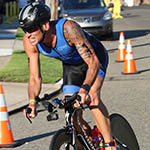
Racing in hot and humid summer weather can be a challenge. Some additional pre-race preparation may be required—and be ready to alter your race plan on race day—but you can prepare for extremes and still excel in challenging conditions. Here's a few more tips for successfully completing a triathlon in warm weather.
Acclimatize
Training in hot conditions where you'll likely be racing is key. This may mean shifting your workouts to later in the day. Remember: You'll want to acclimatize for the hot weather experience at the end of the race, not before the swim start where you won't have heated up yet.
Tip: The advice we offer for racing in hot weather also applies to training in cold weather in most circumstances.
Hydrate Early
In the days prior to your race, be extra mindful of your hydration levels. You don't have to overdo it and consume to excess, but if you're getting up at night to go to the bathroom, you're on track.
Be Mindful of Electrolyte Intake
Don't overload on salt and other necessary minerals and electrolytes. Rather, take care to eat well and as frequently as possible, and you'll be race-ready. Sports nutrition is always a good option to augment natural foods and to ensure you're taking on enough electrolytes, minerals, protein and carbohydrates.
Reduce Your Warmup
If you swim for your warmup and the water temperature is greater than you're used to, consider doing half of your normal routine. If you ride your bike before racing, maybe ride just enough to be in Zone 2, with a few short bursts at race pace adjusted downward for heat. If your run warmup is 2 miles, try reducing it to 1 mile—just enough to break and sustain a sweat.
Leave the Wetsuit Behind
Even if triathlon wetsuits are permitted on race day (per USAT rules, it has to be below 84 degrees), a wetsuit will heat you up very quickly. If you're doing a swim longer than 1500m, consider leaving the weatsuit behind completely. You don't want to overheat while swimming and then have to follow it with a hot bike and an even hotter run.
Don't Double up on Swim Caps
If you use two swim caps—your own cap and the race cap—wear only the race cap. This will allow for some heat dissipation through your head, and you will not fatigue as quickly.
Adjust Your Effort
If you use a powermeter on your bike, you'll have a precise way to monitor your effort. Reduce your target power by 10 percent for 40K and shorter distances; for longer distances, consider dropping your power by as much as 15 percent from your normal target output.
Monitor Your Output
If you race with a heart rate monitor, keep an eye on your heart rate so it doesn't get too high. For sprint distance events, don't go more than about three percent above your threshold heart rate on the bike; for Olympic distance races, keep your BPM to five percent below threshold. For longer events, consider keeping your heart rate 10 percent lower than normal out of transition, and gauge how you feel after 60 minutes of riding, and adjust accordingly. When running, keep an eye on your heart rate—it will likely be higher than normal at any given pace, and if you don't keep it in check, you may suffer before you make it to the finish.
Bike and Bathe
If there are hydration stations on the bike route—especially in longer-distance races—consider grabbing water and dumping it on your neck, shoulders and head to keep as cool as possible for as long as possible.
Adjust Your Run
The larger you are, the more heat will affect you. You should know your target run pace before race day, so slow your roll by 30 to 90 seconds per mile depending on the heat and humidity, as well as the distance you're racing. It's OK to be conservative with your pace when you run out of transition; if you're feeling good toward the end of your run, you can pick up the pace.
Ice Often
For races that offer ice packs, towels or sponges soaked in ice water along the run route, take advantage of this amenity and cram as much coolant into your tri kit as you can. If you wear a hat while racing, do whatever you can to keep your head cool.
Walking Is OK
If you feel like you're overheating, it's OK to walk. But know that it will be hard to pick back up again after doing so—especially if you're suffering from the heat. Walking should be a last-resort strategy, but one that will still get you across the finish line.
READ THIS NEXT: 5 Hydration Tips for Triathletes


